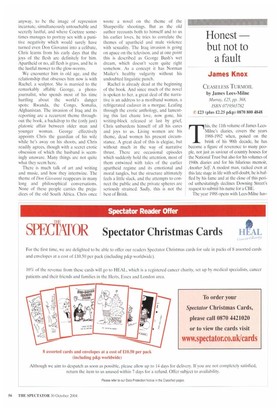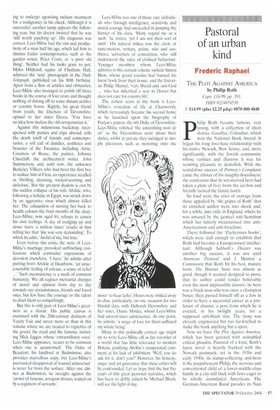Honest but not to a fault
James Knox
CEASELESS TURMOIL
by James Lees-Milne Murray, £25, pp. 368, ISBN 0719565782 £23 (plus £2.25 p&p) 0870 800 4848
This, the 11th volume of James LeesMilne's diaries, covers the years 1988-1992 when, poised on the
brink of his 90th decade, he has become a figure of reverence to many people, not just as saviour of country houses for the National Trust hut also for his volumes of 1940s diaries and for his hilarious memoir, Another Self. A modest man, racked even at this late stage in life with self-doubt, he is baffled by his fame and at the close of this period unhesitatingly declines Downing Street's request to submit his name for a CUE.
The year 1988 opens with Lees-Milne hav ing to undergo agonising radium treatment for a malignancy in his cheek. Although it is successful, another lump appears the following year, but his doctor insisted that he was 'still worth patching up'. His diagnosis was correct Lees-Milne had the vim and productivity of a man half his age, which led him to dismiss frailer contemporaries, such as the garden writer, Peter Coats, as 'a poor old thing'. Neither had his looks gone to pot. Myles Hildyarcl, squire of Flintham Hall, admired the 'sexy' photograph in the Daily Telegraph, published on his 80th birthday. Apart from a flow of articles and obituaries, Lees-Milne also managed to polish off three books in the course of four years and thought nothing of driving off to some distant archive or country house. Rightly, his great friend from youth, the Duchess of Devonshire, opined to her sister Decca, `You have no idea how tireless the old octogenarian is.'
Against this industrious backdrop, interspersed with parties and trips abroad, tolls the death knell of friends and contemporaries, a roll call of dandies, aesthetes and beauties of the Twenties, including Anne, Countess of Rosse, the painter, Johnnie Churchill, the architectural writer, John Summerson, and, until now, the unknown Berkeley Villiers, who had been the first boy to seduce him at Eton, an experience recalled as 'thrilling, alarming, wicked-seeming and delicious'. But the greatest shadow is cast by the sudden collapse of his wife Alvilde, who, following a holiday in Egypt, was struck down by an aggressive virus which almost killed her. The exhaustion of nursing her back to health colours the final months of the diary. Lees-Milne, now aged 84, refuses to censor his own feelings. A day of trudging up and down stairs 'a million times' results in him telling her that 'she was very demanding'. To which he adds, 'Awful of me, but true.'
Even before this crisis, the state of LeesMilne's marriage provoked unflinching confessions which contradict expressions of devotion elsewhere. 'I have,' he admits after parting from Atvilde at Heathrow, 'an unaccountable feeling of release, a sense of relief Such inconsistency is a mark of common humanity. We all register mercurial changes of mood and opinion from day to day towards our circumstances, friends and loved ones, but few have the courage or the talent to chart them so compellingly.
But this is only part of Lees-Milne's greatness as a diarist. His public canvas is crammed with the 20th-century denizens of Vanity Fair and never more so than in this volume where we are treated to vignettes of the grand, the royal and the famous, including Mick Jagger, whose 'extraordinary voice' Lees-Milne appraises, 'ceases to be common when one is accustomed'. The Duke of Beaufort, his landlord at Badminton, also provides marvellous copy, but Lees-Mitne's puritanical disapproval of 'wastrel aristocracy' is never far from the surface. After one dinner at Badminton, he inveighs against the 'crowd of fatuous, arrogant drones, waited on by a regiment of servants'. Lees-Milne was one of those rare individuals who through intelligence, sensitivity and moral courage had succeeded in jumping the barrier of his class. 'Many regard me as a snob,' he writes, 'yet I am not their sort of snob.' His natural milieu was the circle of taste-makers, writers, artists, wits and aesthetes, subverters of convention, who still understood the rules of civilised behaviour. Younger members whom Lees-Milne admires in this current volume include Simon Blow, whose grand cousins had banned his latest book from their house, and the historian Philip Mansel, 'very liberal and anti-God ... who has inherited a seat in Dorset but does not care for country life'.
The richest seam in the book is LeesMilne's evocation of life at Chatsworth, which increasingly became his second home as he launched upon the biography of Paxton's patron, the 6th Duke of Devonshire. Lees-Milne relished 'the astonishing train de vie' as the Devonshires went about their duties, whilst in private they indulged in simple pleasures, such as motoring onto the moor `to hear larks'. Hours were whiled away in chat, particularly, on one occasion for two blissful days, with Deborah Devonshire and her sister, Diana Mosley, whom Lees-Milne had adored since adolescence. At one point, he admits, 'a surge of love for them suffused my whole being'.
Many in this politically correct age might try to write Lees-Milne off as the recorder of a world that has little relevance to modern Britain, justifying Alvilde's exasperated comment at his lack of inhibition: 'Well, you do ask for it, don't you?' However, his honesty, anger arid art guarantee that these critics will be confounded. Let us hope that the last five years of this great personal narrative, which has been so deftly edited by Michael Bloch, will see the light of day.



















































































































 Previous page
Previous page